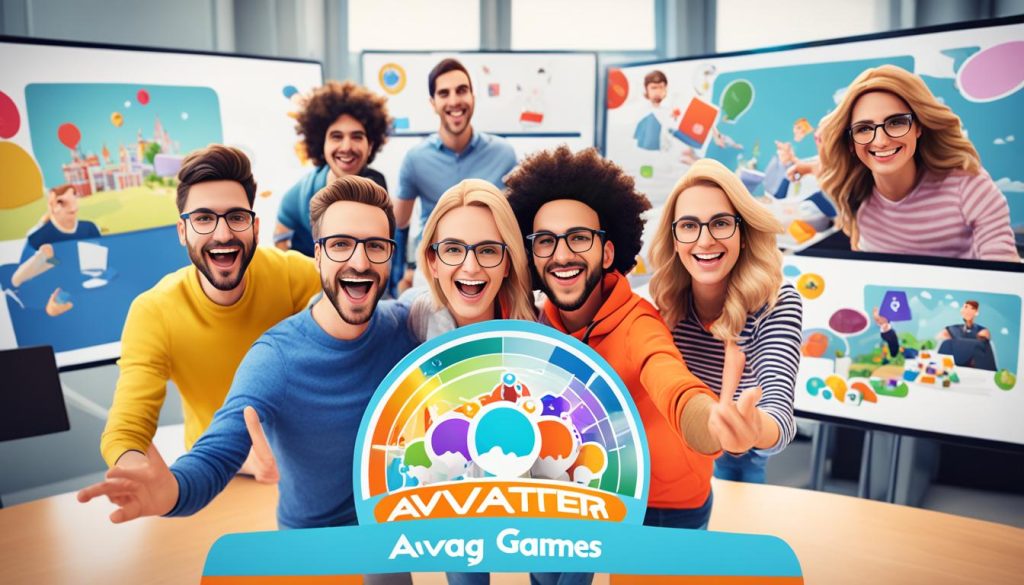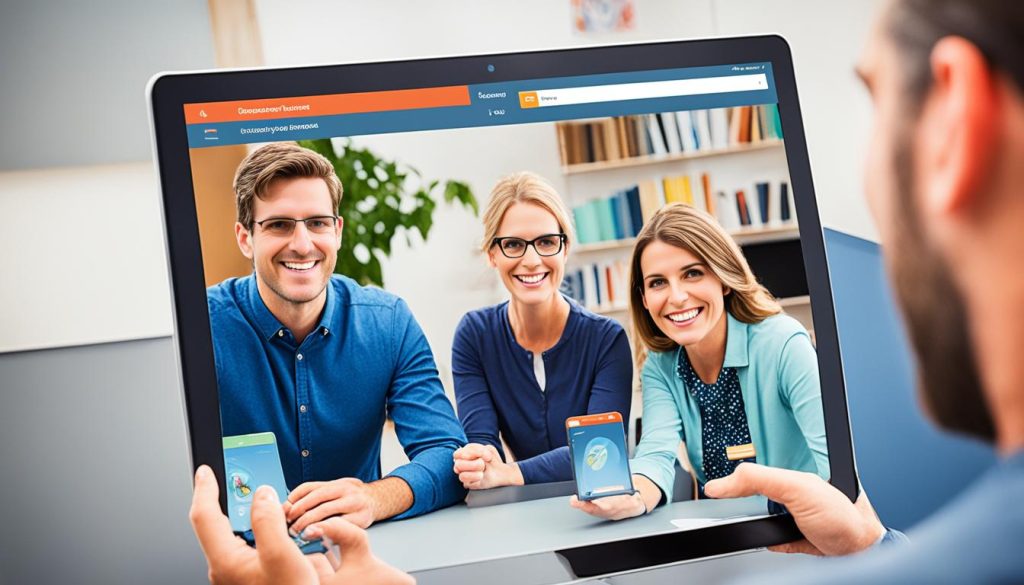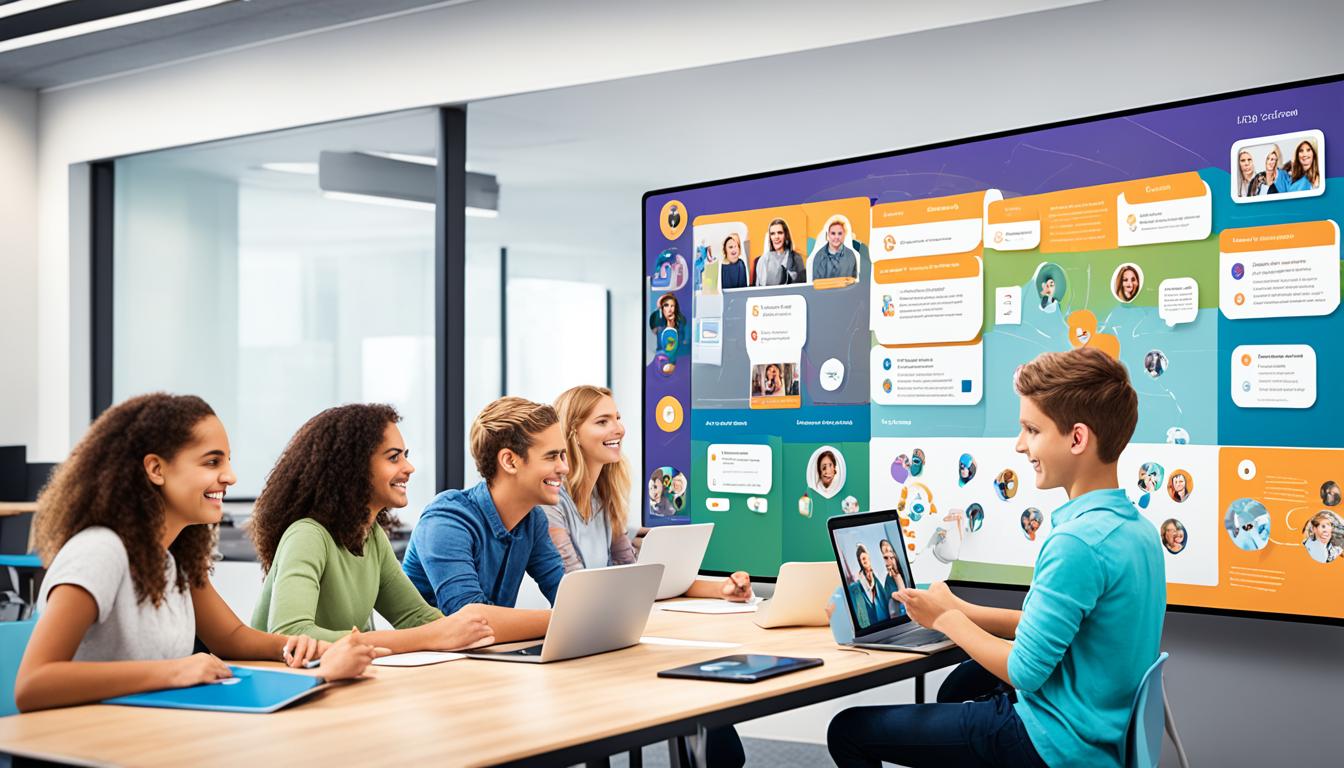The digital era has transformed the way we learn, and eLearning platforms have played a pivotal role in this revolution. These platforms offer interactive educational experiences that captivate learners, foster engagement, and promote knowledge retention. With their immersive multimedia content, gamification techniques, interactive assessments, collaborative learning opportunities, adaptive learning and personalization features, and more, eLearning platforms have created a new paradigm for education.
Today, interactive e-learning platforms have become the go-to choice for individuals seeking engaging online learning experiences. These platforms provide a wealth of benefits, including immediate access to resources, real-world simulations, microlearning opportunities, and the ability to track progress and performance. Moreover, these platforms are cost-effective and scalable, making quality education accessible to a wide range of learners.
Key Takeaways:
- Interactive e-learning platforms have revolutionized education by offering immersive multimedia content, gamification techniques, and collaborative learning opportunities.
- These platforms provide personalized and adaptive learning experiences, catering to individual needs and optimizing learning outcomes.
- Interactive assessments and immediate feedback enhance the learning process and allow learners to measure their progress effectively.
- Collaborative learning environments foster a sense of community, encourage critical thinking, and broaden perspectives through diverse interactions.
- eLearning platforms promote lifelong learning by providing continuous learning, microlearning opportunities, and easy access to educational resources.
Immersive Multimedia Content
eLearning platforms have revolutionized the learning experience by incorporating immersive multimedia content. With the integration of films, interactive quizzes, simulations, and Virtual Reality experiences, learners now have access to a diverse range of materials that make their learning journey engaging and interactive.
Immersive multimedia elements not only capture learners’ attention but also facilitate a deeper understanding of complex concepts. By appealing to multiple senses, eLearning platforms enhance interactive learning experiences and promote effective knowledge retention.
“The use of multimedia content in eLearning allows learners to engage with the material in a more dynamic and interactive manner, resulting in a deeper understanding of the subject matter.”
For example, incorporating videos or animations into eLearning courses helps visualize abstract concepts, making them easier to comprehend. Interactive quizzes and simulations provide learners with hands-on practice, allowing them to apply their knowledge in a practical setting.
Virtual Reality experiences transport learners to different environments, creating a highly immersive and realistic learning environment. They can explore historical sites, participate in virtual experiments, or practice real-world skills, making their learning experience more vivid and engaging.
Enhanced Engagement and Boosted Knowledge Retention
By leveraging immersive multimedia content, eLearning platforms enhance learner engagement and promote active participation. These elements tap into learners’ natural curiosity and create a sense of excitement, ultimately fostering a love for learning.
Research has shown that incorporating multimedia content into eLearning experiences improves information retention. When learners can visualize concepts and actively interact with the content, their retention and comprehension rates increase significantly.
Immersive multimedia content also supports diverse learning styles by catering to different preferences and aptitudes. Visual learners benefit from videos and images, while kinesthetic learners can engage in interactive simulations or Virtual Reality experiences that allow them to practice and apply their knowledge.
Incorporating immersive multimedia content into eLearning not only enhances learners’ overall experience but also helps them achieve a deeper understanding and retention of the subject matter.
Gamification: Learning Made Fun
Gamification is a powerful technique used in eLearning to make the learning process more enjoyable and interactive. By incorporating game elements like points, badges, leaderboards, and challenges, eLearning platforms transform educational content into a stimulating game-like experience.
With gamification, learners are motivated to progress, compete with others, and achieve milestones, fostering a sense of achievement and accomplishment. It creates a positive learning atmosphere that keeps learners engaged and excited about their educational journey.
“Gamified eLearning environments promote healthy competition, improve motivation, and create a positive learning atmosphere.”
Engaging in a gamified eLearning platform encourages healthy competition among learners, pushing them to do their best and surpass their own limits. Through interactive course platforms, learners can track their progress, compare their performance to peers on leaderboards, and strive to reach the top.
Gamification also enhances motivation, as learners are rewarded with points, badges, and virtual rewards for their achievements. These incentives provide a sense of immediate gratification and a tangible representation of progress, keeping learners motivated and eager to explore more topics and complete more challenges.
The Benefits of Gamification in eLearning
- Improved engagement and participation
- Enhanced motivation and enjoyment
- Fosters a sense of achievement and accomplishment
- Encourages healthy competition
- Provides immediate feedback and progress tracking
Gamified eLearning platforms create a dynamic and interactive learning experience that taps into learners’ natural curiosity and competitive instincts. By incorporating gamification into educational programs, we can turn traditional learning into a fun and engaging adventure.

Interactive Assessments And Feedback
Traditional assessments often lack interactivity and immediate feedback. In contrast, eLearning platforms offer interactive assessments that provide instant feedback and explanations. Learners can measure their comprehension, pinpoint areas for development, and receive personalized feedback catered to their performance through interactive quizzes and real-time evaluations.
This immediate feedback loop enhances the learning experience, promotes active learning, and allows learners to track their progress effectively. Gone are the days of waiting for test results or wondering where improvements can be made. With real-time feedback, learners can make adjustments and adapt their learning strategies, leading to better outcomes.
“The interactive assessments offered by eLearning platforms have completely transformed the way we evaluate learning. With instant feedback, learners are empowered to take control of their educational journey and continuously improve.”
Aside from providing instant feedback, interactive assessments also help learners engage more dynamically with the course material. By allowing learners to actively participate in the learning process, they become more invested in their own education. When learners receive immediate feedback on their performance, they are motivated to reflect on their mistakes, identify areas for improvement, and make necessary adjustments.
Furthermore, interactive assessments facilitate a deeper understanding of the subject matter. Through interactive quizzes and evaluations, learners are encouraged to think critically, apply their knowledge, and develop problem-solving skills. This not only boosts knowledge retention but also prepares learners for real-world challenges where problem-solving and critical thinking skills are paramount.
With interactive assessments and real-time feedback, eLearning platforms provide a personalized and adaptive learning environment. Learners can track their progress, identify areas of strength, and focus on areas that need improvement. This targeted approach ensures that learners receive the most relevant and tailored content, optimizing their learning potential.

| Benefits of Interactive Assessments | Benefits of Real-Time Feedback |
|---|---|
|
|
Collaborative Learning Opportunities
Collaborative learning is a key aspect of eLearning platforms, enabling students to interact with instructors and peers from around the world. Through discussion forums, chat rooms, and virtual classrooms, learners can engage in meaningful conversations, share viewpoints, and benefit from diverse interactions. Collaborative learning fosters a sense of community, encourages critical thinking, and broadens perspectives.
With eLearning platforms that prioritize collaboration, students have the opportunity to collaborate on projects, work on group assignments, and participate in interactive activities together. This collaborative approach not only enhances engagement but also allows learners to tap into the collective knowledge, skills, and experiences of their peers.
E-learning platforms with collaboration features enable students to work on tasks together, share resources, provide feedback to one another, and learn from different perspectives. By engaging in collaborative learning, students develop vital skills such as communication, teamwork, problem-solving, and empathy.
“Collaborative learning is not only beneficial to students but also to instructors. It allows educators to facilitate discussions, monitor progress, and provide guidance, promoting a dynamic and interactive learning environment.” – Professor Emily Thompson, eLearning Expert
Through collaborative learning, students are exposed to a diverse range of ideas, opinions, and approaches, leading to a more comprehensive understanding of the subject matter. They learn to appreciate different perspectives and cultivate critical thinking skills by engaging in constructive discussions and debates.
Furthermore, collaborative learning in eLearning platforms nurtures a sense of belonging and strengthens the sense of community among learners. Students feel a greater connection to their peers and instructors, enhancing their overall learning experience.
Benefits of Collaborative Learning in eLearning:
- Promotes active engagement and participation
- Fosters critical thinking and problem-solving skills
- Enhances communication and teamwork abilities
- Expands knowledge through diverse perspectives
- Strengthens sense of community and belonging
By leveraging collaborative learning opportunities within eLearning platforms, students can develop essential skills and gain a deeper understanding of the subject matter. The collaborative aspect of eLearning enriches the learning experience, empowering students to become active contributors and lifelong learners.

Adaptive Learning And Personalization
eLearning platforms have revolutionized the way we learn by incorporating adaptive learning and personalization. With the help of advanced algorithms and Artificial Intelligence, these platforms can analyze learners’ progress, identify their strengths and weaknesses, and deliver customized content accordingly.
The beauty of adaptive learning lies in its ability to tailor the learning experience to each individual’s needs. By providing personalized e-learning platforms, learners receive the most relevant and targeted material, ensuring that their time is optimized and spent on valuable content.
Imagine a student who struggles with math but excels in literature. An adaptive eLearning platform can recognize this and provide extra practice exercises and resources in math while offering challenging literature assignments. This tailored approach not only enhances engagement but also accelerates learning outcomes.
Furthermore, adaptive learning and personalization reduce the time spent on irrelevant content. Learners can focus on areas where they need improvement, enabling them to progress at their own pace and achieve a deeper level of understanding.
The benefits of adaptive learning and personalization extend beyond the individual learner. These features can also be beneficial in a classroom setting, where teachers can monitor individual progress and adapt their teaching methods accordingly. By catering to students’ unique learning styles and abilities, personalized e-learning platforms promote a more inclusive and effective learning environment for all.
Personalized learning is like a GPS for education. It identifies where a student is, where they need to go, and the best route to get there.
Enhancing Learning Outcomes with Adaptive Learning
Research has shown that adaptive learning can significantly improve learning outcomes. A study conducted by the University of California concluded that students who used adaptive learning systems scored higher on exams and demonstrated a deeper understanding of the subject matter compared to those who used traditional learning methods.
The key to the success of adaptive learning lies in its ability to provide instant feedback and continuous assessment. Learners receive immediate feedback on their performance, allowing them to identify their areas of strength and weakness. This feedback loop enables students to take corrective actions and fill knowledge gaps, leading to more effective learning.
Moreover, adaptive learning platforms offer real-time progress tracking, allowing learners to visualize their growth and development. This transparency encourages motivation and a sense of accomplishment, further driving learners towards achieving their educational goals.
The Future of Personalized e-Learning Platforms
The evolution of personalized e-learning platforms is an exciting prospect for the future of education. As technology advances, these platforms will continue to refine their algorithms and offer even more tailored learning experiences. We can expect to see enhanced personalization, adaptive assessments, and individualized learning pathways that adapt to each learner’s unique needs.
By harnessing the power of adaptive learning and personalization, e-learning platforms will play a crucial role in shaping the future of education. The ability to provide customized content, targeted feedback, and a personalized learning journey will empower learners to take control of their education, fostering lifelong learning and growth.

| Benefits of Adaptive Learning and Personalization | Examples |
|---|---|
| Enhanced engagement | Interactive quizzes, gamified learning activities |
| Accelerated learning outcomes | Targeted content based on strengths and weaknesses |
| Reduced time on irrelevant content | Customized learning paths |
| Individualized learning experience | Personalized feedback and progress tracking |
Conclusion
eLearning has revolutionized education by providing interactive and engaging learning experiences. Through the integration of multimedia content, gamification, interactive assessments, and collaborative learning, eLearning platforms capture learners’ attention, enhance understanding, and promote knowledge retention. These interactive educational platforms offer a seamless and flexible learning environment, empowering learners to take control of their education.
The personalized and adaptive nature of eLearning ensures that learners receive tailored content that matches their individual needs. With continuous learning, microlearning, immediate access to resources, and the ability to track progress and performance, learners are equipped with the tools to succeed. These interactive e-learning platforms foster a love for learning and promote lifelong learning as technology continues to develop.
As we forge ahead into the future, the role of interactive e-learning platforms in education will only grow. By providing engaging learning experiences, these platforms have the potential to transform education globally. With their ability to captivate learners’ attention, enhance understanding, and promote knowledge retention, interactive educational platforms are at the forefront of innovation in education. Embracing these technologies can create a more inclusive and effective learning experience for all learners.




No comments! Be the first commenter?